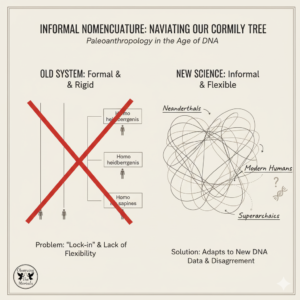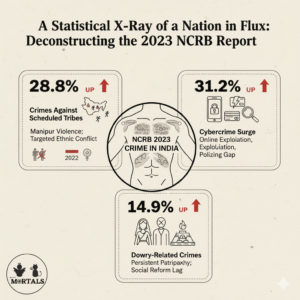Have you ever wondered why receiving a gift creates an immediate, unspoken obligation to give one back? Why does a simple act of giving, which appears voluntary and generous, carry so much social weight? This fundamental human experience was the subject of one of the most influential texts in anthropology: Marcel Mauss’s 1925 essay, The Gift. Mauss looked at archaic societies and uncovered a system of exchange that was not about economics as we know it, but about forging the very bonds that hold societies together. This case study delves into his revolutionary theory, which remains profoundly relevant in understanding everything from international diplomacy to the likes and shares of our digital world.
2. The Information Box
Syllabus Connection:
- Paper 1: Chapter 3 (Economic Anthropology), Chapter 2 (Social-Cultural Anthropology), Chapter 6 (Anthropological Theories).
Key Concepts/Tags:
- Reciprocity, Gift Exchange, Total Social Phenomenon, Kula Ring, Potlatch
3. The Setting: Who, What, Where?
This is not a traditional ethnography based on a single site. Instead, the French sociologist and anthropologist Marcel Mauss (nephew of Émile Durkheim) conducted a groundbreaking comparative study. He synthesized a vast amount of existing ethnographic data, most notably Bronisław Malinowski’s work on the Kula Ring in the Trobriand Islands (Melanesia) and Franz Boas’s research on the Potlatch ceremonies of the indigenous peoples of the Pacific Northwest Coast of North America. By comparing these diverse systems of exchange, Mauss aimed to uncover a universal logic behind the act of giving.
4. The Core Argument: Why This Study Matters
Mauss’s central argument was that in archaic societies, gifts are never truly free. They appear voluntary but are, in fact, obligatory and create a powerful web of social, political, and spiritual relationships. He broke this down into three key insights:
- The Three Obligations: Gift exchange is governed by a set of fundamental obligations that bind individuals and groups:
- The Obligation to Give: To show one is generous, powerful, and to initiate a social relationship.
- The Obligation to Receive: To refuse a gift is to refuse the social relationship, an act of hostility. Accepting it is to accept the bond.
- The Obligation to Reciprocate: This is the most crucial part. The return gift, often of greater value, must be made to prove one’s honor and maintain the social relationship.
- The “Spirit of the Gift” (Hau): Mauss’s most unique insight was explaining why the gift must be returned. Drawing on the Maori concept of hau, he argued that the gift contains a part of the giver’s spiritual essence or soul. This “spirit” of the gift desires to return to its original owner. Therefore, to hold onto a gift for too long is dangerous and spiritually improper. This spiritual dimension is what distinguishes a gift from a simple commodity and ensures the cycle of reciprocity continues.
- The “Total Social Phenomenon”: Mauss concluded that gift exchange is a “total social phenomenon.” This means it is not a purely economic activity. An act like the Potlatch is simultaneously economic, political (establishing hierarchy), religious (connected to spirits and ancestors), legal (creating binding obligations), and social (forging alliances). You cannot understand it by looking through any single lens.
5. The Anthropologist’s Gaze: A Critical Perspective
- Idealization vs. Coercion: Critics have pointed out that Mauss’s model can sometimes idealize gift exchange as a purely harmonious activity. The Potlatch, for instance, involved fierce competition and the destruction of wealth to shame rivals, showing that reciprocity can be aggressive and coercive, not just integrative.
- The Hau Controversy: The interpretation of the Maori concept of hau has been debated by later anthropologists, who questioned whether Mauss’s “spirit of the gift” was an entirely accurate reading or a romanticized European projection.
- Relevance in Capitalism: A key question is the model’s relevance in modern capitalist societies, where anonymous market transactions with commodities (which, unlike gifts, are stripped of personal essence) are dominant.
6. The Exam Angle: How to Use This in Your Mains Answer
- Types of Questions Where It Can Be Used:
- “Define reciprocity and explain its significance in tribal economies with ethnographic examples.”
- “What is a ‘total social phenomenon’? Explain with reference to Marcel Mauss’s work.”
- “Compare and contrast the Kula Ring and the Potlatch as systems of exchange.”
- Model Integration:
- For a basic definition: “Reciprocity, as conceptualized by Marcel Mauss in his work ‘The Gift’, is a system of exchange based on the three obligations of giving, receiving, and reciprocating, which serves to create and maintain social relationships.”
- For a deeper analysis: “Beyond simple exchange, Mauss argued that the obligation to reciprocate is driven by the ‘spirit of the gift’ or hau, a belief that a part of the giver’s essence is contained within the object, creating a spiritual imperative for its return. This elevates the gift beyond a mere commodity.”
- To show theoretical breadth: “Mauss classified gift exchange as a ‘total social phenomenon’ because it is simultaneously an economic, political, religious, and legal act. For example, the Potlatch was not just about exchanging goods but about establishing social hierarchy and fulfilling spiritual duties.”
7. Mentor’s Take
Marcel Mauss’s The Gift is one of those rare texts that fundamentally changes how you see the world. His genius was to look at what seemed like simple economic acts and reveal the hidden social grammar underneath. He taught anthropologists to always ask: what is this action really doing? The enduring lesson from Mauss is that no economic act is ever just economic. It is always embedded in a web of social relationships, power dynamics, and cultural meanings. Understanding this is key to moving beyond a superficial analysis of any society, ancient or modern.




